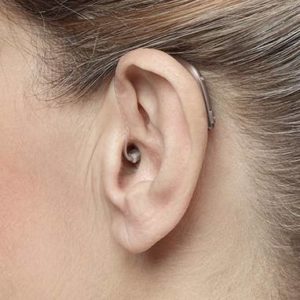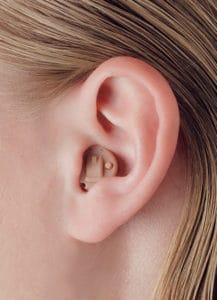Behind-the-ear or In-the-ear hearing aids
What’s right for me?
There are a number of different hearing aid styles available but you might be surprised to hear that not every style of hearing aid is right for every level of hearing loss.
At Protea Wellness Audiology we will only recommend a style of hearing aid once we have conducted a comprehensive hearing test. Once we have your audiogram (the graph that tells your level of hearing loss) we will discuss with you what style of hearing aid will offer you the greatest benefits and results so you can make an informed decision.

Behind the ear hearing instruments
The electronics of the behind-the-ear hearing aid sit inside a small housing (shell) that rests on the top of the ear. The housing is connected by a wire (known as a “receiver”) or, in some cases, a tube. At the end of the wire or tube connects a dome or a custom made mould or tip which sits in the ear canal.
At our clinic, the most widely recommended and purchased hearing aids fall within the behind-the-ear style and are known as RIC which stands for “Receiver-in-Canal”. That’s because these hearing aids are suitable for people that range from mild to profound hearing loss.
RICs are discreet, provide a natural and crisp sound, and are easier to be adjusted and repaired compared to the so-called ITE (In-The-Ear) hearing instruments discussed below. In users with mild to medium hearing loss, RICs allow for the user to continue to use all their remaining hearing abilities as sounds can continue to naturally travel into the ear, thereby reducing the need to artificially reproduce all frequencies which is the case with ITE hearing instruments.
Receiver-in-canal (RIC) hearing aids sit behind the ear and deliver sound directly into the ear. The hearing aid and receiver are connected by a discreet ‘receiver wire’ which houses an electrical cable.
After sound has been processed through a microphone (part of the housing) and amplified to your specific hearing needs, the sound must be delivered into your ear. That's the job of the receiver (the wire that connects the housing). Once the receiver receives the electrical signal from the amplifier, it converts it back into sound.
Receivers come in different power levels, this means that if your hearing deteriorates over a period of time, it may be possible to change the receiver power level without the need to purchase a brand new hearing aid like you would with an ITE hearing instrument.
RICs are also versatile, not only can the colour of the housing be selected, most models come as battery powered or rechargeable so you can decide what’s best for you.

In the ear hearing instruments
The electronics of the in-the-ear hearing aid sit inside a custom made hardshell mould. The smallest version is known as the CIC (completely-in-canal), the medium-sized option is known as ITC (in-the-canal) and the largest instrument is named after its namesake; ITE (in-the-ear). The CIC fits deeply inside the ear canal, ITC is small enough to fit almost entirely in your ear canal and the ITE is made to fit within the external ear.
ITE's are recommended for people with very profound hearing loss because of the power they can generate. As they block the entire ear, less natural sound will be picked up by the ear, instead, all sounds are picked up by the microphone and artificially amplified and converted into sound through a receiver that is built inside the shell.
The ITE hearing instrument can be ideal for someone with very limited dexterity and reduced vision.
As the ear canal can change in shape and size over time, ITEs may need to be re-shelled periodically and as this is not covered under warranty, ITEs can become more costly over time. Most repairs of ITE instruments have to be done by the manufacturer as all its elements sit inside the hard shell.
